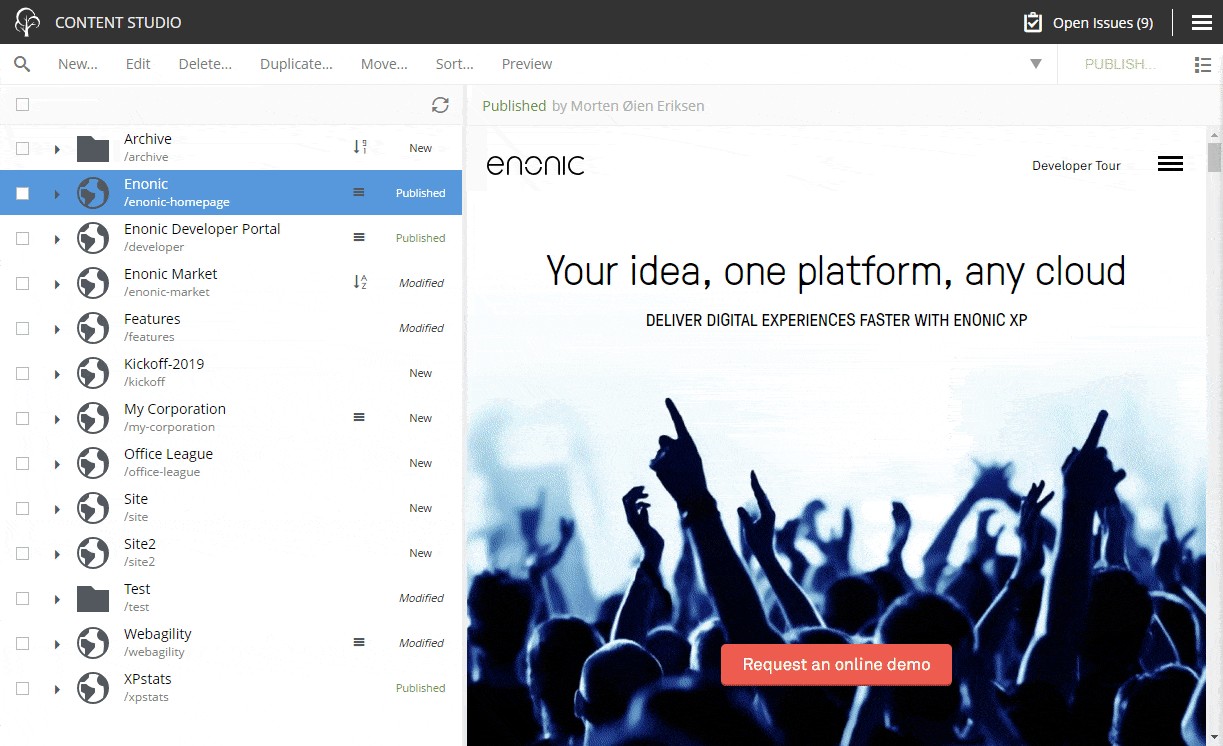Optimizely (Episerver) vs. Enonic
How do Optimizely and Enonic compare? Here is an essential overview of similarities and differences.
Written by Morten Eriksen on

How do Optimizely and Enonic compare? Here is an essential overview of similarities and differences.
Written by Morten Eriksen on
It might be difficult to navigate the market of content management systems and web platforms. To help you consider essentials between certain contenders, we have crafted this presentation of Optimizely versus Enonic, so you can get a tidy overview.
Optimizely is a global software company founded in Sweden in 1994 under the name Episerver, and is owned by American private equity firm Insight Partners. In October 2020, Episerver acquired the digital experimentation company Optimizely, and later changed name as well.
The company’s main product is the Digital Experience Platform, built on Microsoft .NET technologies. It is a digital marketing suite which includes separate solutions for CMS, e-commerce, campaigns, search, personalization, and social media. The CMS solution features user management, access control, WYSIWYG interface, and A/B testing.
Optimizely is closed source and available in several plans—and you have to request information to learn more about included features and functionality.
The use cases of Optimizely focus on eCommerce and Global marketing sites.
Enonic was founded in Norway in 2000. The company’s content platform is delivered as a ready to use cloud service or software to host in your own cloud. With Enonic you can configure content models, access content using the GraphQL API, manage landing pages, and integrate contextual preview. This enables you to build modern websites and content experiences to support multiple touchpoints in the digital customer journey.
The platform features an integrated storage and search engine enabling storing of any data, including user generated content. The CMS interface “Content Studio” features a WYSIWYG interface, permissions and roles management, version control, multi-site management, localization and advanced image editing. Enonic adheres to a “best of breed” strategy, where the core product is lightweight and robust, while integration with third-party services that are best in their respective industries is not only possible, but actively encouraged.
Enonic is open-source, meaning you can try it extensively before subscribing to the cloud service or software support. It is also a hybrid CMS, which means that developers can use the headless API to distribute editorial content to any device or client, but you can also build custom APIs, extend the user interface, and deploy integrations.
The use cases Enonic focus on are modern stack websites, global marketing sites and customer portals.
See also: Drupal vs. Enonic »
Users on the review platform G2 have the following to say about Optimizely:
“Our company uses optimizely to do site personalization and a/b testing. What I love best about optimizely is that changes can be done in real time rather than waiting for things to publish,” says Angela.
“The Optimizely Digital Experience platform lets us provide a personalized funnel for each of our customers. It also facilitates efficient collaboration across multiple teams (including designers, developers, and product managers),” says a user in computer software.
“Optimizely’s Digital Experience Platform (DXP) solves a critical customer problem... it simplifies & streamlines the creation process,” says an internal consultant in computer science.
“What I dislike is that it is still hard to find pages, blocks, or assets using the edit mode search. Also, switching block or media tab in the assets panel, the CMS still unselects the current folder and the content editors has to go through all the folders again to find what she/he wanted,” says an administrator in computer software.
“The SLA for an SaaS solution is dependent on the underlying cloud platform. The other aspect of Optimizely to keep in mind is the protection against risks of malicious piosoning of served contents,” says Angus.
“The system is pretty complicated, which requires developer experience in order to customize some parts. The UI feels outdated,” says a user in computer software.
G2 users have the following to say about Enonic:
“I like the flexibility of the Enonic. You can choose from several approaches on how to use the system. We, for example, take advantage of the Headless CMS, where our client part is created in Angular. The definitions of the content structures are entirely in our hands and can describe both simple and very complex data.” says Pavel.
“I like the UX which anyone with a tad of prior experience from blog systems and WordPress-like systems will recognize,” says Håvard.
“Enonic is versatile, robust and user-friendly. I love the hybrid approach, combining both headless and traditional editorial functionality. We use it for multiple sites at Gjensidige, and have successfully integrated it with our design system,” says Torstein.
“I would love to see an improvement in tutorials and code examples that could inspire us to take more advantage of the platform,” says an administrator in Financial Services.
“I would have liked an even bigger community, so please consider trying it out,” says Torstein.
“The documentation could be better and include more complex examples. It would also be nice if there were more apps on market.enonic.com,” says an agency in Information Technology and Services.
See also: WordPress vs. Enonic »
| Optimizely | Enonic XP |
|---|---|---|
Coding language | .NET | JavaScript |
Database requirements | Yes, Microsoft SQL Server | None, embedded NoSQL |
License | Proprietary | GPLv3 with linking exception and commercial license for paying customers |
Source code | Closed | |
Integrated search | Yes, pluggable API | Yes, based on Elasticsearch |
Headless/decoupled | Yes, through a headless API | Yes, based on GraphQL |
Flexible content types | Yes, page types | Yes |
WYSIWYG page editor | Yes | Yes |
Responsive UI | Yes | Yes |
Image editor | Yes | Yes, including focal point and image service |
Page template editor | No, requires coding | Yes |
SEO management | Yes, add-on | Yes, app from Enonic Market |
Version control | Yes | Yes |
Video content | Yes, embedding | Yes, embedding |
Hosting | Microsoft Windows Server, Microsoft Azure | Linux or Windows Server, Any Cloud, Enonic Cloud |
Support plans | Yes, by vendor or solution partner | Yes, by vendor |
Free support | Forum, email | Forum, Slack |
Community | Yes | Yes |
Training | Yes, by third party or vendor | Yes, by vendor |
Plugins | Yes, add-ons | Yes, apps from Enonic Market |
Due to its closed nature, it is difficult to assess the Optimizely Digital Experience Platform independently. From available data, it is possible to point out that the CMS features a content tree structure, a visual editor, context menus, and an asset menu with blocks, media, templates, and forms.
In Enonic you decide the location of a content in a logical tree structure. Once the blog post draft is created, you can navigate through fields systematically, before saving, previewing, and finally publishing:

Essential reading: What makes Enonic awesome »
As always, what CMS you should choose depends on your context and a variety of factors. Optimizely may be expensive, but comes with many advanced services in its pre-packaged suite. If content marketing and e-commerce is most important, Optimizely might be the right solution for you. But remember that you need .NET expertise.
If your focus is on building services and content, or running things headlessly, Enonic might be the preferred choice. Enonic can easily integrate with best of breed tools for personalisation, A/B testing, SEO optimisation, and so on. Also, Enonic is open source and offers more flexibility and speedy development with fast solutions and the newest technology.
As for customer journeys, both Optimizely and Enonic cover this need thoroughly—with their respective content management systems working as a hub for distributing content to different channels. Enonic offers a flexible solution with headless CMS, microservices, and APIs, while Optimizely may be a bit more rigid due to its locked-in solution and fixed marketing suite.
First published 29 May 2019, updated 31 August 2022.
Get some more insights: